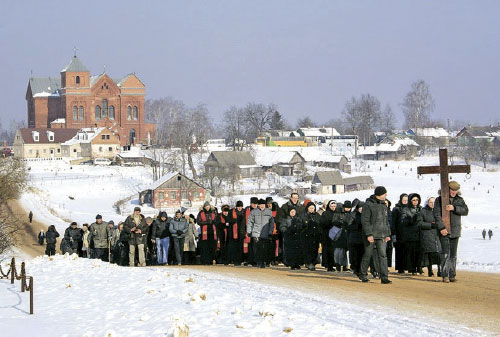
Sacred procession to honour the memory of those died during the war years
During punitive action in February 1943, the fascists burnt the two priests together with other inhabitants of the village. The Germans had offered the priests a chance to escape, but they chose to share the tragic fate of their parishioners. In 1999, Pope John Paul II announced that the Rositsa martyrs Jerzy and Antoni were to be beatified as part of the process of beginning sainthood. Since then, pilgrims from many countries have come to Rositsa to pray to them, and also to pay their respects to the memory of the 1,528 local residents killed that day. On this occasion, the memorial service in the Church of the Holy Trinity attracted more than 300 visitors from the Verkhnedvinsk District, from Minsk, Vitebsk, Polotsk, Glubokoe, Miory and Borisov. It was given special importance by the presence of the Apostolic Nuncio in Belarus Archibishop Claudio Gugerotti.
Church from red brick
Today Rositsa is a small village located 10 kilometres from the Latvian border. At the start of the 20th century it was already the largest Catholic parish in the Vitebsk province. In 1911, a new church with beautiful tall towers was built but these were unfortunately destroyed in 1934 as a measure to reduce supposed enemy targets. The religious persecutions of the following year meant that the church was temporarily abandoned. In the autumn of 1941, the Druya monks sent Father Antoni Leszczewicz to Rositsa. A native of the Vilna region, he also had experience of missionary work in the Far East. 81-year-old Valentina Martsinkevich who lives in the neighbourhood of Rositsa recollects how he held services, “For me Antoni was like a father. He taught us to pray, to obey our parents. I liked to go to his church where the organ played and where people sang songs.”
In the summer of 1942, the Roman Catholic priest Jerzy Kaszyra came to Rositsa. The life of priests, like all villagers, was hard. During the day the occupying forces were in charge, whilst at night there were partisans to deal with. From 1942, anyone caught engaged in partisan activity or co-operation was the subject of punitive reprisals. The monastic leaders recommended missionaries suspend any activity involving the rebellion groups but they refused to leave Rositsa.
In a fiery whirlwind

Remember forever
In Rositsa I talked to pilgrims such as the priest Vyacheslav Adamovich who had brought a group of young people from Miory, he told me, “The places stained with the blood of martyrs draw believers. People come here to be established in the faith, and representatives of the clergy learn by the example of the Rositsa priests.”
After divine service, the pilgrims join a procession with lighted candles to the place of martyrdom. I spoke to Irina Zhernosek, the author of a book devoted to the Rositsa tragedy. She spoke of her work on the artistic-historical novel Thy Will Be Done where she met with eyewitnesses such as the Nun Yadviga Virshuta who escaped from Rositsa. She also talked to Anna Zhuravleva whose mother was burnt before her eyes. The book published in 2004 is a heartfelt response to the tragic history of our native land.
A high cross is mounted on the place where the deaths occurred. Nearby the priest in charge of the Church of the Holy Trinity, Father Cheslav Kurechko (who is the ‘Person of Year of the Vitebsk Region-2013’) and Apostolic Nuncio in Belarus Archibishop Claudio Gugerotti said a prayer. The Archbishop gave the blessing of Pope Francis to the pilgrims: ‘We pray for peace and calmness in Belarus. We ask God to give us happiness and the strength to be not masters of people but to be part of our community. To remember the act of these martyrs as evidence of love for the Lord, their native land and its people’.
The inhabitants of Rositsa are always glad to have visitors. On the road to the memorial there are green thujas plants, symbols of life, while prickly blackthorn and red barberries remind us of their sufferings.
By Sergey Golesnik
Fact
Several weeks after the Rositsa reprisals against civilians, a German officer came to Druya where the nuns had been sent at the insistence of Father Leszczewicz. He interrogated the sisters about what had happened in the village on February 16-18th, 1943. After the war, a document containing the memoirs of these escaped nuns arrived at the monastic offices in Rome. It was printed on a printing machine and had no return address. It was the first concrete evidence of the tragedy in Rositsa and it is still unknown who printed it and what aim they had in mind by sending it to the authorities in Rome.
Today
Rositsa church returned to life in the late 1980s. The decayed roof was repaired, new benches were brought. In the main sanctuary the artist Valerian Yanushkevich created the icon of the martyrs Jerzy and Antoni. While the towers of the church have not regained their initial shape, being lower, they are in good condition and the church and community is thriving.











